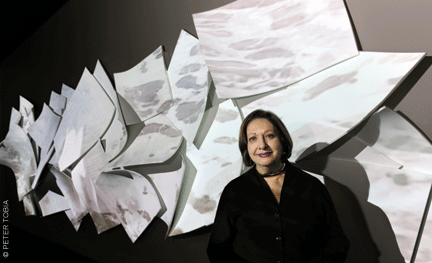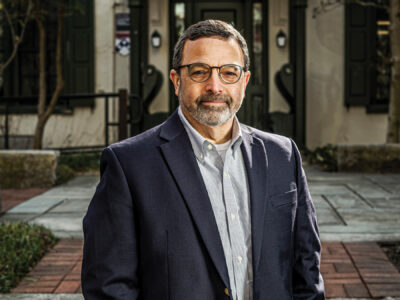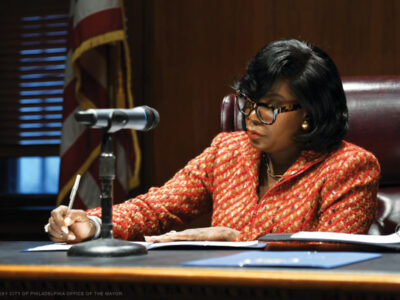
Class of ’56 | When Gwen Goodman Ed’56 was teaching second-graders at West Philadelphia’s Overbrook Elementary in the 1960s, she never imagined she’d someday need her own hard hat. But now she has one: a bright yellow topper symbolizing the years she spent stewarding the National Museum of American Jewish History (NMAJH) into its brand new home on Independence Mall.
Goodman’s office is also decorated with a blown-up black-and-white photo portraying an unlikely group of American Jews. The women wear little straw hats and full skirts. One of the men holds a long horn, used to round up stragglers. Another holds a sign that reads, This way to the Jewish picnic. They’re homesteaders from the mid-to-late 1800s. It’s a surprising photo—homesteading isn’t what comes to mind when one thinks of Jews in America. It’s one of many improbable stories told by the museum, which opened in November with a star-studded gala featuring Bette Midler and Jerry Seinfeld and a surprise appearance by Barbra Streisand.
There wasn’t nearly enough space in the museum’s former home—a 6,000-square-foot gallery attached to the historic Mikveh Israel synagogue—to cover the story of the American Jewish experience. The core exhibition stopped at 1945. The new five-story, 100,000-square-foot NMAJH wends its way chronologically from the top floor, starting in 1654 with the arrival of Jewish refugees from Brazil and ending with the present. “In creating this museum, one of the things I felt was very important,” says Goodman, “was to bring history right up to the present in order to involve the younger generations and really get them to think about the history that’s happening around them so they can help to shape their future.”
Encouraging younger generations to engage with history has been Goodman’s modus operandi since she graduated from Penn with a degree in education. After spending five years under the tutelage of painter Ernst Krupp in Germany, she returned home to work as a public-school teacher. As a painter, she had museums on the brain and wondered whether they could be transformed into teaching institutions. “I wanted to do something that would really open the doors of museums for all people,” says Goodman, “not just the people who own these collections or the privileged people who visited museums at that time.” She applied for a School District of Philadelphia program that placed teachers in seven of the city’s museums and was hired for a position at Independence National Historical Park. She was thrilled.
Goodman was Independence Mall’s resident educator during the years preceding the nation’s bicentennial. Soon after NMAJH opened at Mikveh Israel on July 4, 1976, she was asked to join the board. In 1982 she left the museum-educator program to start her own company doing educational consulting for museums.
“When I got into museum education, it was a whole new field,” she says. One of the programs she co-created during this time was the Peopling of Philadelphia, which sought to bring together kids from different schools and neighborhoods. “Many times,” says Goodman, “it was the first time that, for example, a mostly African-American class had an opportunity to interact with a mostly Hispanic class, or with people who were different from themselves.”
Eventually Goodman’s consulting company broadened its scope to include nonprofit organizations and issues like board management and strategic planning. Consulting for seven years on the United States Holocaust Memorial Museum in Washington was a pinnacle.
“It was a once-in-a-lifetime opportunity to work on a project of that caliber and nature,” she says. Convinced she couldn’t top it, Goodman retired when the gig was over.
The NMAJH reeled her back in. The museum’s director left in 1999, and the board asked Goodman to step in as interim director. Within two years she went from interim to executive director. The board had just begun talking about adding on to the existing museum, and a feasibility study concluded that it would take $11 million to do so. Goodman thought it would be easier to raise $85 to $100 million for an entirely new museum. But where would they put it? Then one of her fellow board members told Goodman he’d heard that the KYW building at Fifth and Market streets was going up for sale, and she brought the opportunity before the board. “It’s truly one of the great corners of Philadelphia,” she says.
After quickly deciding to buy the property, the board was disappointed to find out it had already been sold. Luckily, the developer who bought it was sympathetic to the museum’s mission and agreed to sell to them at the price he’d paid ($9.5 million), with no premium. The KYW building was razed, and the museum began to go up.
The building is a distinctive modern presence on a very historic square. Its glass façade telegraphs the notion that Jews in America can be visible—they don’t have to hide behind walls. The terra cotta that serves as the skin for much of the building pays respect to Philadelphia, a red-brick city, and to the museum’s famous neighbors on the Mall. The views from the balconies on each floor illustrate why this is the perfect location for a museum about the American Jewish experience. “To your left is [Independence Hall], where the Declaration of Independence was adopted; and to the right you have the Constitution Center,” Goodman says, “but this museum tells the practical story of what happens when you live under those two documents.”
Goodman and her team of historians decided at the beginning that the overarching theme of the museum would be freedom.
“The reason many history museums fail is because they don’t have a story,” she says. “They have lots of little stories, but they don’t have a big story. Our story is the story of freedom, the foundations of freedom, the dreams of freedom, and the responsibilities, choices, and challenges that freedom brings.” She smiles to herself as she admits she’s lived through several floors—and themes—of the museum, starting with the fourth floor, which spans 1880 to 1945.
She ticks off the exhibits she has personal experience with: Jews moving to the suburbs; Jewish summer camps; leisure time in the Catskills; feminism and the civil rights movements; and anti-Semitism. “When I was going to Penn it was difficult for Jewish people to get into the graduate schools,” she says. “There were numbers of people that didn’t get in because they were Jews, not just at Penn, but at all of the Ivy League schools. When young people hear about that today, they are shocked.”
A recent debate over whether the museum would be open on Saturdays wasn’t shocking, but it did become national news. It was a sticky question: Saturday, the day of Sabbath, would be the busiest day for the museum. How could they keep from alienating those who observe the Sabbath? The riddle had been on the board’s collective mind since they green-lighted the new building.
Last August they convened a special committee to consult other institutions, rabbis, and Jews of denominations ranging from Orthodox to humanistic. In the end, a compromise was approved: The museum is open on Saturdays but doesn’t sell tickets on the premises; the gift shop, though open, doesn’t handle cash that day, and credit-card purchases aren’t processed until after sundown.
“It was a great teaching moment. It really gave people something to think about,” says Goodman, noting that the story was picked up by the Associated Press and most of the Jewish press. “It made people examine the problem from many perspectives to realize you can stray from a strict law and still be respectful.”
Goodman tried to retire once before, and now she’ll try again. She has stepped down as executive director and is fending off offers as she prepares to leave her office on the Mall. This time she knows better than to say never.
—Caroline Tiger C’96




